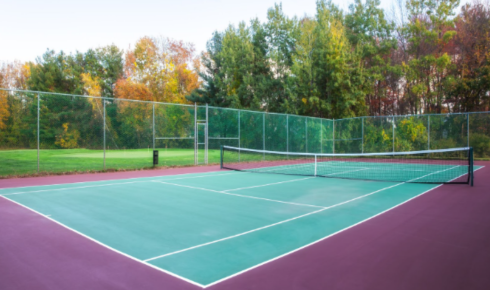
tennis court surface
In the world of tennis, the choice of tennis court materials plays a vital role in shaping performance, safety, and long-term durability. From club-level courts to competitive arenas, the surface impacts every serve, slide, and bounce. Among the many tennis court surface options, synthetic acrylic flooring has emerged as the leading choice for modern tennis court construction.
Understanding Tennis Court Materials
Tennis court materials range from traditional clay and grass to more modern hard surfaces like concrete and synthetic coatings. Each type has its benefits and drawbacks depending on climate, usage, and maintenance capabilities. However, for those seeking consistency, safety, and cost-efficiency, synthetic tennis court material—especially acrylic flooring—offers an unmatched combination of features.
What is Synthetic Acrylic Flooring?
Synthetic acrylic flooring is a high-performance, multi-layered coating system composed of acrylic resins, rubber granules, and silica aggregates. This tennis court floor material is applied over an asphalt or concrete base, creating a resilient and weather-resistant surface. It is known for its ability to maintain excellent ball bounce, provide traction, and reduce joint impact.
The flexibility and strength of acrylic sports flooring make it the top choice for outdoor tennis court flooring material in diverse weather conditions, especially in regions like India.
Benefits of Synthetic Acrylic as Tennis Court Flooring Material
- Weather Resistance: Synthetic acrylic is UV-resistant and water-repellent, making it ideal for outdoor tennis court material exposed to intense sunlight and rain.
- Consistent Bounce: The smooth, textured surface offers uniform ball response, ensuring a fair game every time.
- Shock Absorption: Acrylic courts provide moderate cushioning that helps reduce injuries, particularly important for long training sessions.
- Slip Resistance: Players can make aggressive movements with confidence thanks to the court’s anti-skid surface.
- Low Maintenance: Easy to clean and resistant to wear and tear, synthetic acrylic flooring requires minimal upkeep compared to other types of tennis court flooring material.
- Customizable: Courts can be finished in various colors and designs to match branding or tournament standards.
- Environmentally Friendly: Many suppliers offer low-VOC formulations, making it a more sustainable choice.
Synthetic Acrylic vs. Other Tennis Court Surface Options
| Surface Type | Bounce Consistency | Maintenance | Weather Durability | Injury Risk |
| Grass | Low | High | Low | Medium |
| Clay | Medium | High | Medium | High |
| Hard Concrete | High | Medium | High | High |
| Acrylic Flooring | High | Low | High | Low |
Clearly, acrylic sports flooring offers the best balance for those seeking reliable performance and durability.
Tennis Court Resurfacing Materials
For existing courts, tennis court resurfacing materials using synthetic acrylic offer a cost-effective solution to upgrade worn-out or cracked surfaces. The acrylic system can fill in imperfections, smooth the surface, and renew court performance without a complete overhaul.
Professionals also use tennis court crack repair material as part of the resurfacing process to address structural issues before applying the new acrylic layers. This prolongs court life and minimizes the need for frequent repairs.
Choosing Reliable Tennis Court Material Suppliers
Sourcing materials from reputed tennis court material suppliers is essential for ensuring quality and longevity. Trusted suppliers provide certified, high-grade acrylic coatings, along with support for tennis court installation, customization, and maintenance.
They also offer a full range of tennis court flooring materials, including primers, cushion coats, color coats, and line-marking paints—all engineered to work seamlessly together.
Ideal for All Levels of Play
Whether for residential setups, schools, clubs, or international-level courts, synthetic acrylic delivers consistent quality across use cases. Its durability and playability make it a favorite for players of all skill levels—from beginners to professionals.
Moreover, it supports multipurpose use, often seen in facilities where outdoor tennis court flooring material must adapt to other sports like pickleball or badminton.
Conclusion
When evaluating tennis court surface options, synthetic acrylic stands above the rest. Its combination of durability, safety, low maintenance, and consistent performance makes it the best tennis court material available today.
For builders and facility managers, investing in high-quality synthetic tennis court material ensures a court that remains reliable, professional, and player-friendly for years. Choose trusted tennis court material suppliers to access premium coatings, expert advice, and long-lasting results.
If you’re planning a new court or resurfacing an existing one, consider synthetic acrylic flooring—a smart, future-proof investment in world-class tennis infrastructure.

